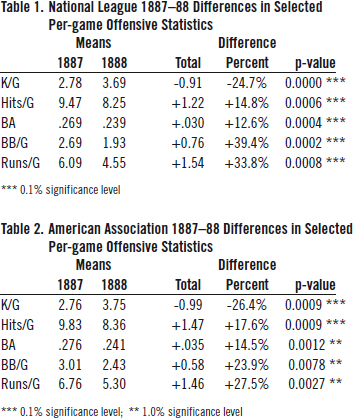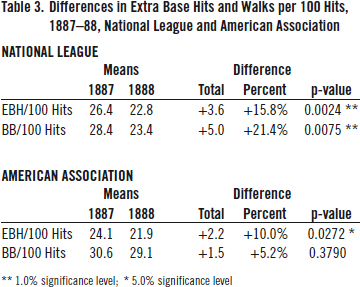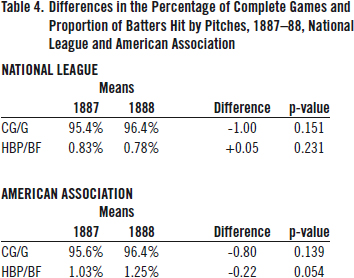The Impact of the One-Off 1887 Four-Strike Strikeout
This article was written by Woody Eckard
This article was published in Fall 2022 Baseball Research Journal
In 1887, for the only time in major league history, a strikeout required four strikes. Giving hitters an extra strike obviously would increase offensive production. However, an interesting (and unanswered) question is the size of the increases across various performance measures. This article presents the first statistical analysis of this issue, made possible by the 1888 reversion to three strikes, and by the availability of offensive performance data for teams in both the National League and American Association, the two major leagues of the day.
PITCHER-BATTER RULE CHANGES IN 18871
The 1870s through 1880s was an era of organizational tumult in professional baseball, with teams and leagues coming and going, and almost annual experimentation in playing rules with non-trivial changes. Those concerning pitching and batting had major impacts on the critical pitcher-batter interaction and thereby on performance outcomes. Changing the rules was a balancing act, with rules advantaging pitchers disadvantaging batters, and vice versa.
Probably the most significant single year for pitcher-batter rule changes was 1887. The main change favoring pitchers was the elimination of the batter’s right to request either a high or low pitch.2 The purpose of this change was to relieve umpires of the chore of calling two separate “high-low” strike zones, but it constituted a major boon for pitchers by roughly doubling the strike zone. This created a problem for rule-makers who were already concerned about a declining trend in offensive production—created by a combination of previous rule changes and improved fielding—and associated attendance declines.
They countered by simultaneously introducing three rule changes that favored batters. The most important of these was the four-strike strikeout (4SK). This gave batters additional swing(s) that inevitably would increase offensive output. The second offsetting rule change was a decrease from six to five in the number of balls required for a base on balls, which of course would produce more walks, but also placed greater pressure on pitchers to throw hittable pitches, thereby increasing the number of hits as well. The third “change” was actually several related changes restricting the pitcher’s delivery in ways that helped the batter. For example, the pitcher was required to begin his delivery with his back foot set on the back line of the pitcher’s box, and he was allowed only one step toward home before delivering the pitch, similar to the modern delivery.
Another one-year rule change introduced in 1887 affected the computation of batting averages (BAs): a base on balls was counted as a hit (and an at-bat), creating significant increases in BAs. This was not a playing-field rule change to the pitcher-batter interaction, but it might have influenced batters’ behavior by causing some to seek a base on balls to “pad” their BAs, which at the time were the principal measure of hitting prowess.
In what follows, we report 1887 BAs computed conventionally, i.e. not counting bases-on-balls as hits or at-bats. This can be easily done with available data, and avoids what would otherwise be a significant exaggeration of the 4SK impact. We also test the BA “padding” hypothesis.
MEASUREMENT OF THE 4SK IMPACT
Isolating the impact of the fourth strike, however, is problematic given the multiple simultaneous rule changes. Hershberger (2019, 211) correctly observes: “In 1887, offense was actually higher than in 1886 (although concurrent change to the delivery [and other] rules make [sic] it difficult to assign credit to any particular rule change).”3 Similarly, Thiessen (2018, 252) concludes that, as compared to 1886, “the cumulative advantages that [the 1887] rule changes afforded to the batsman contributed to the significant improvement in the productivity of the players, teams, and leagues” (emphasis added), and no conclusion was drawn regarding individual rule changes.4 Indeed, isolating the performance impact of any single rule change introduced in 1887 by a comparison with 1886 is impossible given available data.
However, a “work-around” is possible. In 1888, when MLB reverted to the three-strike strikeout, the other major rules governing the pitcher-batter interaction that were introduced in 1887 remained unchanged. And no new rules related to pitching and batting were introduced. Thus, an estimate of the inevitable decline in offensive performance from eliminating the 4SK is possible. This, in turn, can serve as an estimate of an “all-else-equal” introduction of the 4SK rule assuming symmetry, i.e., the two impacts are equal in magnitude but opposite in effect. This is the basis of the estimates presented below.
MAIN IMPACTS ON OFFENSIVE STATISTICS
We first examine five key offensive statistics affected by the rule change. Separate results are reported for the National League (NL) and the American Association (AA), comparing the 1887 and 1888 seasons. The NL had the same eight teams in both years. The AA had seven that were the same in both years, having replaced the Metropolitan Club with Kansas City in 1888. Team performance data are from Baseball-Reference.com.
The comparisons are shown in Tables 1 and 2 for the NL and AA, respectively. All metrics are league averages and all are reported on a per game basis, except BA, to adjust for differences in the number of games played between the teams and the two seasons. The performance differences are calculated subtracting 1888 data from 1887 data, treating a performance decline from 1887 to 1888 as an estimate of the increase that would have occurred from 1886 to 1887 under an all-else-equal implementation of the 4SK. Statistical significance is measured by p-values for a matched-pairs difference-between-means test for teams in each league.
The most obvious result of the 4SK is fewer strikeouts. They fell in both leagues by similar amounts, 0.91 per game in the NL and 0.99 per game in the AA, proportionate decreases of roughly one-quarter.
For those at-bats that reached a three-strike count, the additional strike meant at least one additional pitch, producing a second obvious result: more hits. Hits per game increased in both leagues, by 1.22 in the NL and 1.47 in the AA, proportionate increases of roughly one-sixth. Thus, BAs increased, from .239 to .269 (.030 points) in the NL and from .241 to .276 (.035 points) in the AA. Recall that we compute BAs ignoring the 1887 walk-equals-hit rule.
The additional pitches generated by the fourth strike could, of course, be balls, leading to the less obvious result of more walks. Also, three-strike counts would be more likely to occur with weak batters and/or strong pitchers. In both cases batters might be more likely to take borderline pitches hoping for a walk. Note that this happens even without the walk-as-hit BA calculation. In fact, bases-on-balls increased in both leagues, by 0.76 per game in the NL and 0.58 per game in the AA.
More hits and walks together increased the number of baserunners, which in turn created more runs. The NL had 1.98 additional baserunners per game, and the AA had a very similar 2.05 per game. The AA’s lead in hits per game (1.47 vs 1.22) was nearly offset by the NL’s lead in walks per game (0.76 vs 0.58), resulting in similar increases in runs per game of 1.54 (NL) and 1.46 (AA).
Note that all the differences reported in Tables 1 and 2 have a high degree of statistical significance, despite the small sample sizes. The reported p-values indicate that all NL metrics pass a 0.1 percent significance test. In the AA two pass a 0.1 percent test (K/G and Hits/G), while the remaining three pass a 1.0 percent test. Strikeouts per game decreased for all teams in both leagues. Similarly, all four offensive metrics of Tables 1 and 2 increased for all teams in both leagues. Thus it is extremely unlikely that the observed changes were mere happenstance.
Myriad factors affect batter and pitcher performance from year to year, and are in a constant state of flux across teams and individual players. However, it is generally reasonable to view such changes as statistical noise, i.e., random offsetting factors with a mean zero expected impact. The above significance tests address the likelihood of this assumption being wrong. A possible factor not falling in this group concerns pitchers’ adjustments to the 1887 delivery rule changes mentioned above. If these adjustments were not complete by the end of the 1887 season, a lingering impact might have existed in 1888, in which case our estimates might be somewhat overstated.
BATTERS’ STRATEGIC REACTION
Another interesting question is the batters’ reaction to the 4SK in terms of their approach to at-bats. We analyze two such possible changes. First, batters could “spend” the additional swing on a “power stroke” looking for an extra base hit (EBH), most likely early in the count. The associated “cost,” more swings-and-misses, would be mitigated by the extra strike.5 This would be evident as a larger proportion of EBHs.
Second, as noted above, another unique 1887-only rule change involved counting a base on balls (BB) as a hit when calculating BAs. This may have created an incentive to draw BBs to pad BAs, i.e., batters electing to take extra borderline pitches. An implication is more BBs relative to hits, i.e., an increase in the BB/Hit ratio.
Table 3 presents data on EBHs and BBs per 100 hits for both leagues. First, EBH per 100 hits increased by 3.6 in the NL and 2.2 in the AA. The larger NL increase might explain the above noted larger NL increase in runs. While neither EBH increase is large, both are statistically significant. Thus, at least some batters were likely using the extra strike for a “power stroke.”
Regarding more BBs, however, the results are mixed. The NL shows a statistically significant increase of 5.0 percentage points in the ratio of BBs to hits, consistent with batters padding BAs. In contrast, while the AA ratio shows an increase, it is insignificant. Perhaps the higher BA batters in the AA (see Tables 1 and 2) were simply less inclined to trade hits for walks.
IMPACT ON PITCHING
Another question of interest is the impact of the 4SK on pitching. First, basic pitching effectiveness measures such as ERA, WHIP, and the K/BB ratio necessarily mirror the above changes in hitting performance, and so will not be detailed here. In sum, these measures deteriorated as related offensive performance measures improved.
However, two other pitching-related questions remain open. First, did pitchers respond to the fourth strike by more “purpose pitches” designed to keep batters from getting too comfortable at the plate? This would be evident as an increase in the proportion of batters faced (BF) hit by pitches (HBP). Both statistics are available in 1887 and 1888.6 Second, did managers use more relief or “change” pitchers in response to the offensive surge?7 This implies fewer complete games (CG), a statistic also available during the study period.
The data are presented in Table 4 for both the NL and AA. The HBP percentage (HBP/BF) shows a trivial change for the NL. But the AA HBP percentage change is contrary to the prediction. It is lower in 1887 compared to 1888, by 0.22 percentage point, although falling just short of significance at the 5 percent level. Perhaps concerns about the significant BB increase noted above (Tables 1 and 2) created a countervailing pressure on pitchers to throw strikes.
Regarding the use of change pitchers, both the NL and AA CG percentages (CG/G) show a decline, but both are small and statistically insignificant.
SUMMARY AND CONCLUSIONS
The offensive performance impacts of the unique 1887 4SK cannot be measured by comparison to 1886 performance because of the confounding influence of several other pro-batter rule changes also introduced in 1887. However, these other rule changes remained in place when the three-strike strikeout was restored in 1888. Thus the impacts of removing the 4SK can be measured by comparing 1887 and 1888 performance metrics. These in turn can be used to estimate the impacts of its introduction assuming equal but opposite effects.
As expected, the data reveal that strikeouts per game in both the NL and AA declined as a result of the 4SK; hits and BAs increased; and, less obviously, walks also increased. The result was more baserunners that in turn produced more runs, which indeed was the objective of the rule change. All the measured changes were substantial and statistical tests demonstrate they were very unlikely to be happenstance. An increase in the proportion of extra-base hits in both leagues indicates that batters responded in part by using the extra strike for a power stroke. However, the results were mixed regarding the hypothesis that batters were also seeking walks to pad their BAs because of the simultaneous walk-equals-hit rule.
Two possible impacts of strike-four on pitching were analyzed. The results do not support the hypothesis that the offensive surge resulted in more relief (change) pitchers. Also, there was no evidence of an increase in batters hit by pitches, which could result if pitchers responded by increased batter intimidation.
Baseball magnates quickly decided the 4SK was a mistake. In May 1887, only one month into the season, AA owners passed a resolution asking the Joint [AA and NL] Committee on Rules to rescind the rule, along with the base on balls equals hit rule (Thiessen, 2018, 252). The motivations were varied, and apparently did not include the “power surge” per se. Hershberger (2019, 212) notes the following:
[T]he stated reasons were that batters were delaying the game by waiting for two strikes before swinging [walks did indeed increase] and that the one year of the four-strike rule was merely a period for batters to adjust to the new [larger] strike zone, which they now had done. Underneath this is a subtext that the three-strike strikeout had the weight of long tradition behind it, making four-strike outs seem unnatural.
The NL owners agreed. That fall (November 1887), at the annual joint meetings of the two major leagues, the three-strike strikeout was restored (Rippel, 2018, 261). And in 1888 the surge in offensive performance disappeared.
DR. WOODY ECKARD holds the title of Professor of Economics Emeritus at the University of Colorado-Denver Business School, with a PhD in Business Economics from UCLA. He has published over 50 articles in refereed academic journals on a variety of topics. A major focus has been sports economics with eight articles on college sports and five on Major League Baseball, including three on nineteenth century baseball. He is an empty nester living in Evergreen, Colorado, with his wife Jacky and two dogs. He is a Rockies fan, both the baseball team and the mountains, and a SABR member for over 20 years.
Sources
Hershberger, Richard (2019). Strike Four: The Evolution of Baseball. Rowman & Littlefield: New York.
Nemec, David (1999). The Official Rules of Baseball: An Anecdotal Look at the Rules of Baseball and How They Came To Be. Barnes & Noble Books: New York.
Rippel, Joel (2018). “Harmony After a Fire Sale: The 1887 Winter Meetings.” In Baseball’s 19th Century “Winter” Meetings: 1857–1900, edited by Jeremy K. Hodges and Bill Nowlin, SABR: Phoenix, AZ., 260–65.
Shipley, Robert E. (1994). “19th Century Pitching Changes.” The Baseball Research Journal, No. 23, 44–50.
Thiessen, Dennis (2018). “Radical Changes to the Playing Rules: The 1886 Winter Meetings.” In Baseball’s 19th Century “Winter” Meetings: 1857–1900, edited by Jeremy K. Hodges and Bill Nowlin, SABR: Phoenix, AZ, 247–59.
Notes
1. For descriptions of pitching rule changes during the 1880s, see Shipley (1994), Thiessen (2018), Rippel (2018), and Hershberger (2019).
2. Additionally, a strike was officially defined as a pitch over the plate between the knee and shoulder.
3. It should be noted that Hershberger in his book Strike Four made no attempt to quantify the impact of the fourth strike on performance statistics.
4. Thiessen (2018, 247–48) provides tables comparing aggregate league offensive performance in 1887 to 1886 and 1888, although his 1887 data count bases-on-balls as hits, per the new 1887 rule. Also his 1887–88 comparison is not linked to the 4SK. His offensive metrics are among those reported in the present article.
5. At this time, foul balls were not counted as strikes, e.g., see Nemec (1999, 33–34).
6. 1887 was the first year that NL batters were awarded first base when hit by a pitch, the AA having adopted the rule in 1884 (Nemec, 1999, 103–4). Thus, one wonders if the new NL rule was introduced to protect batters in recognition of this possible response by pitchers to the four-strike rule. In this regard, it is surprising that the HBP rate is actually higher today than in 1887, given the “tough-guy” image of 19th century ball players. The 2020 aggregate MLB rate (HBP/BF) was 1.23 percent, compared to the 1887 NL and AA rates of 0.83 percent and 1.03 percent, respectively (Table 4).
7. At this time, a player could not leave a game unless injured. Thus, to be relieved, a pitcher had to change positions with another player already in the game.





